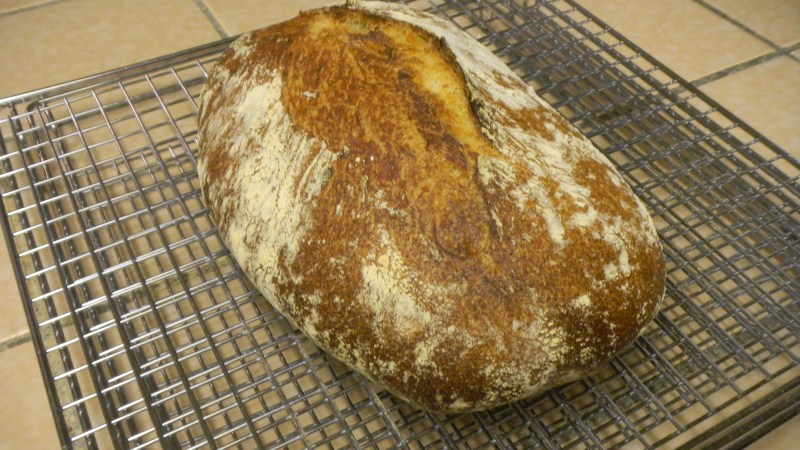
Today's bread for me
Hello,
This is today's bread. It is a 10% rye, the rest a 50/50 mix of KA bread + AP, at an overall 72% hydration. 2-lbs.
20% was the levain sour (125%) for 18 hrs @ 44F, and then heated up. 60% was the flour soaker at 55F (78%), same 18 hrs,... and then also heated up. :-)
Then mixed it together, with the remaining flour, did not have to add any additonal water to achieve 72% hydration. Bulk fermented for an hour, then shaped, final rise for about 3 hours appx... I had cut off a little piece and was watching that and the loaf, not the clock...
All naturally leavened.
After taking out of the oven, I took the pics a little early..... I couldn't wait...
A little better scoring than previously, I got a new blade today. :)





Tastes good!
Happy...


Comments
Great Loaf, gvz! the color, crumb look great!
I could see the wrinkes underneath the loaf. To better seal off the seams and creat a more upright loaf, preshape and rest in slightly floured space. Then, 5 minutes later, swiftly scrape the dough by a dough scraper and shape it, drag it towards you an any shape you like, as the friction underneath will help tighten the surface on your dough's skin. By resting before final shaping, you are sealing the doughs seams underneath. Avoid using too much flour, as the dough my incorporate flour into the wrinkled seams, and will prevent seams from closing.
Best
Khalid
Thanks for the pointer. I always have little wrinkles on the bottom of the loaf, I thought that was normal...
This loaf even has a bit of a buttery taste to it, but I didn't add any butter to it. A good sour, not too strong, not too acidic. Just right. It's amazing what flavors you can coax out of just flour, water, and a bit of salt... I love making bread. :)
Nice looking loaf gvz! I'm curious about one thing. When you say that you "heated up" the levain and the soaker, do you mean warmed up to room temp or actually heated? It's always interesting to hear what other people are experimenting with. I love making bread too.
Hi asfolks. Recently I found these handy things called Koolatrons, basically temperature controllable coolers, but they also heat. For me they can get down to about the freezing point, or up to about 180F. I think they are intended for medical or scientific uses in transferring or storing samples that must be within a fairly precise temp range. They work great for levains, soakers, etc. After the cold 18-hour ferments were done, I simply dialed up the temps to 90F for an hour, to warm them up faster. When I initially took the levain + soaker out, I measured their temps and they were a nice 75F, but the levain wasn't quite ripe enough (yeast ripeness), so I returned it to the warmed chamber for another 30 minutes, and it was perfect. The chambers are big enough to hold a couple of loaves (in bannetons/brotforms) also. I actually did speed up my final (shaped) ferment time a bit by doing that.
Light is green when cooling, and red when heating.
It comes with a tray you can insert half way down if you want..
Thanks again for the tip. It worked. :-) At least I think so, so far. No issue with the underside seam. A couple of very small wrinkles, but not the big ones. If it is photo-worthy, I'll post later. The last bread (from this thread), I found a much more severe seam problem and even worse, some raw flour in the center of the bread. Ugh.
For today, I increased rye to 20% instead of 10% of flour, and then also increased hydration to 75% from 72%, and tossed in a very small amount of diatastic malt into the soaker for the heck of it. (Overall it is 20% rye, 80% mix of AP+bread flour). I used my normal 125% starter and did a 125% levain plus an 80% soaker.
Unfortunately, I did not form the gluten all the way though. A mistake. I can do better. So it's a hockey puck but a good one. :-)
The bread was still steaming when I took these pics... I know, it is bad... but still, I like to have some straight out of the oven.. even if it tastes better the next day, and even if the pics makes it look underbaked because it was still quite warm... It's past midnight... sorry. :)
All naturally leavened, no additional baker's yeast. Over time I have found I do not like the way adding baker's yeast changes the texture. Or maybe it's some flaw of mine... but I prefer the breads I made to leaven with my culture.
Just one little seam mark on the underside -- gar! :-)
Great effort there, gvz! I love the crumb structure, and the crust is beautiful! well done.
You could get away with high hydration doughs by incorporating more stretchs and fold during bulk fermentation. Check your dough as it ferments in the bowl, if it feels sticky and slack due to the hydration, stertch anf fold it in the bowl or on a counter. By the end of fermentation and many stretches and folds, your dough will have a body, and will not excessively spread when loaded into the oven.